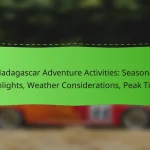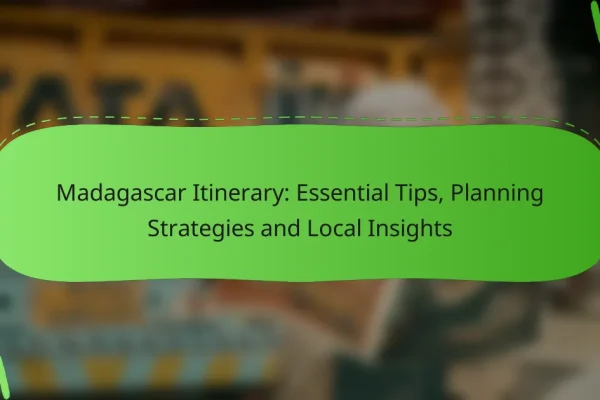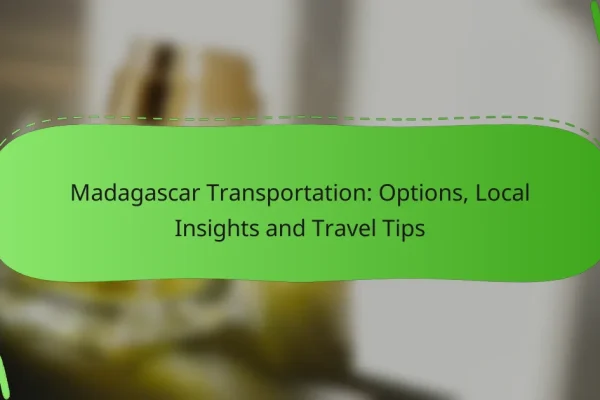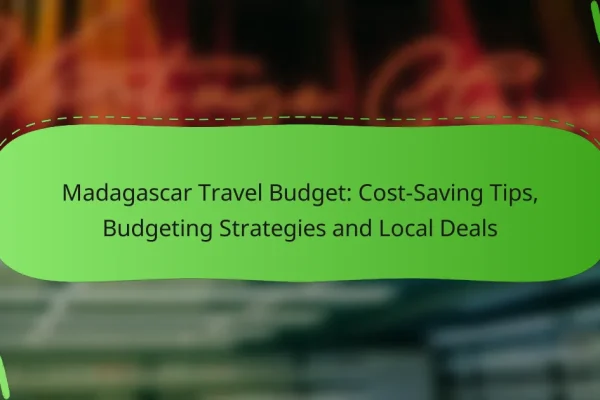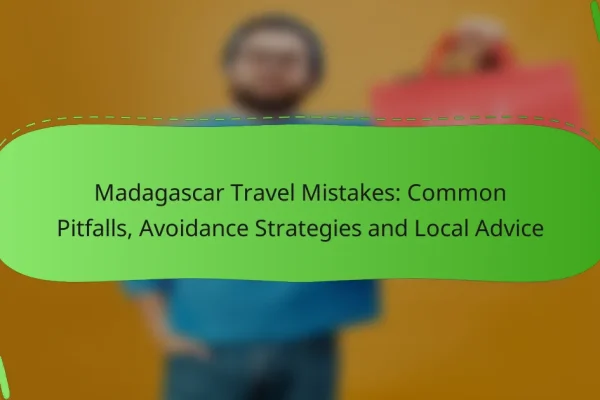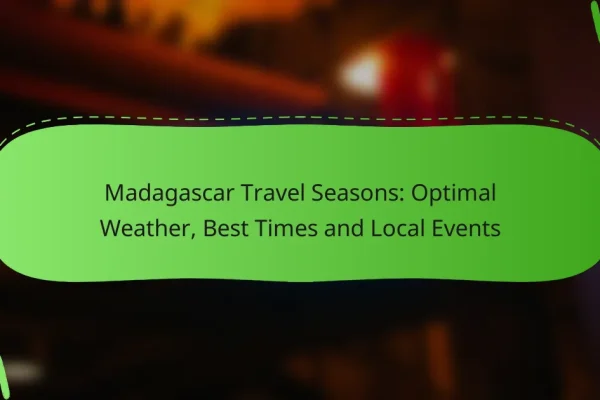What are the best travel packages for Madagascar?
The best travel packages for Madagascar cater to various preferences, including luxury, budget, and family-oriented options. These packages typically include accommodations, guided tours, and transportation, allowing travelers to explore the island’s unique wildlife and landscapes efficiently.
Luxury tours from Intrepid Travel
Intrepid Travel offers luxury tours that provide a premium experience in Madagascar. These packages often include upscale accommodations, gourmet dining, and personalized itineraries that focus on exclusive experiences, such as private wildlife tours and cultural interactions with local communities.
Travelers can expect to pay a higher price for these luxury options, typically ranging from USD 3,000 to USD 5,000 per person for a week-long trip. It’s advisable to book well in advance to secure the best accommodations and experiences.
Budget-friendly options from G Adventures
G Adventures specializes in budget-friendly travel packages that make Madagascar accessible to a wider audience. These tours generally include basic accommodations, shared transportation, and group activities, allowing travelers to experience the island without breaking the bank.
Prices for these packages usually range from USD 1,000 to USD 2,000 per person for a week. Travelers should be prepared for a more communal experience, which can lead to lasting friendships and shared adventures.
Family packages from Exodus Travels
Exodus Travels offers family packages designed to engage all ages while exploring Madagascar. These tours often include family-friendly activities, such as wildlife spotting and cultural workshops, ensuring that both adults and children have a memorable experience.
Family packages typically range from USD 2,000 to USD 3,500 per person for a week, depending on the itinerary and accommodations. It’s recommended to check for specific age requirements for activities and consider the interests of all family members when selecting a package.
What are the top attractions in Madagascar?
Madagascar is home to numerous unique attractions that showcase its rich biodiversity and stunning landscapes. Key highlights include the iconic Avenue of the Baobabs, the lush Andasibe-Mantadia National Park, and the beautiful Nosy Be Island.
Avenue of the Baobabs
The Avenue of the Baobabs is a striking natural monument located near Morondava, featuring a row of majestic baobab trees that are centuries old. This iconic site is particularly stunning at sunrise and sunset, when the trees are bathed in golden light, making it a favorite spot for photographers.
Visitors can explore the area by foot or bicycle, but be mindful of the local environment. Respect the trees and surrounding wildlife, and consider visiting during the dry season (May to October) for optimal weather conditions.
Andasibe-Mantadia National Park
Andasibe-Mantadia National Park is renowned for its rich wildlife, including the famous indri lemurs, which are among the largest living lemurs. The park offers well-marked trails for hiking, allowing visitors to experience its diverse ecosystems, from lush rainforests to cascading waterfalls.
Guided tours are highly recommended to enhance your experience, as local guides can provide valuable insights into the flora and fauna. The best time to visit is during the dry season, when wildlife is more active and trails are easier to navigate.
Nosy Be Island
Nosy Be Island is a tropical paradise known for its stunning beaches, vibrant marine life, and relaxed atmosphere. Popular activities include snorkeling, diving, and exploring the island’s lush interior, which is dotted with plantations and wildlife.
To make the most of your visit, consider staying in one of the beachfront resorts or guesthouses that cater to various budgets. The island is accessible year-round, but the dry season (April to November) is ideal for beach activities and water sports.
What is the best time to visit Madagascar?
The best time to visit Madagascar is during the dry season, which runs from April to October. This period offers pleasant weather, making it ideal for exploring the island’s unique wildlife and landscapes.
Dry season from April to October
The dry season in Madagascar is characterized by lower humidity and minimal rainfall, making it the most popular time for tourists. Temperatures typically range from the low twenties to low thirties Celsius, depending on the region.
This is an excellent time for outdoor activities such as hiking, wildlife watching, and visiting national parks. Popular destinations like Andasibe-Mantadia and Isalo National Park are particularly accessible during these months.
Wet season from November to March
The wet season in Madagascar brings higher humidity and frequent rain showers, especially from December to February. While temperatures can be warm, ranging from the mid-twenties to low thirties Celsius, travel can be challenging due to muddy roads and potential flooding.
This season is less crowded, and some travelers enjoy the lush landscapes and vibrant wildlife, particularly for birdwatching. However, it’s advisable to prepare for possible travel disruptions and to consider visiting the eastern rainforests, which thrive during this time.
How to plan a Madagascar itinerary?
Planning a Madagascar itinerary involves selecting destinations based on your interests, travel duration, and the unique experiences the island offers. Consider factors such as transportation options, local accommodations, and seasonal weather to create a balanced and enjoyable trip.
7-day adventure itinerary
A 7-day adventure itinerary in Madagascar can focus on the island’s stunning natural landscapes and wildlife. Start in Antananarivo, then head to Andasibe-Mantadia National Park to see lemurs and lush rainforests. Consider visiting the Avenue of the Baobabs and the Tsingy de Bemaraha for breathtaking views and unique rock formations.
For a well-rounded experience, allocate time for both guided tours and self-exploration. Ensure you have reliable transportation, as some areas may require 4×4 vehicles. A suggested daily plan might include early morning hikes, afternoon wildlife spotting, and evenings spent enjoying local cuisine.
10-day cultural exploration itinerary
A 10-day cultural exploration itinerary allows for a deeper dive into Madagascar’s rich heritage and traditions. Begin in Antananarivo to explore local markets, historical sites, and museums. Travel to the coastal town of Antsiranana to experience the blend of Malagasy and French cultures.
Include visits to traditional villages, where you can engage with local artisans and learn about their crafts. A day trip to the Royal Hill of Ambohimanga, a UNESCO World Heritage site, offers insights into the island’s royal history. Make sure to sample regional dishes and attend local festivals if your timing aligns.
What are the visa requirements for Madagascar?
Travelers to Madagascar typically need a visa to enter the country, but many nationalities can obtain a visa on arrival. It’s essential to check specific requirements based on your nationality before planning your trip.
Visa on arrival for most nationalities
Madagascar offers a visa on arrival for citizens of many countries, allowing them to stay for up to 90 days. Upon arrival, travelers must present a valid passport, a return ticket, and proof of accommodation. The visa fee can vary, generally ranging from 20 to 50 USD, depending on the length of stay.
It’s advisable to carry cash in USD or EUR to pay for the visa fee, as credit card facilities may not be available at all entry points. Ensure your passport is valid for at least six months beyond your intended departure date to avoid complications.
eVisa options available
Madagascar also provides an eVisa option for travelers, which can be applied for online before your trip. The eVisa allows for stays of up to 90 days and is a convenient alternative to the visa on arrival, especially for those who prefer to have their visa arranged in advance.
The application process typically requires filling out an online form, uploading necessary documents, and paying the fee via credit card. Processing times can vary, so it’s best to apply at least a week before your travel date to ensure timely approval.
How to choose a local guide in Madagascar?
Selecting a local guide in Madagascar involves considering their experience, knowledge of the region, and customer reviews. Look for guides who are licensed, have good communication skills, and can tailor the experience to your interests.
Recommendations from Lonely Planet
Lonely Planet suggests seeking guides who specialize in specific areas, such as wildlife tours or cultural experiences. They recommend checking for local certifications and asking about the guide’s familiarity with the regions you plan to visit.
Additionally, it’s beneficial to inquire about the guide’s language skills, especially if you prefer a guide fluent in English or French. A knowledgeable guide can enhance your experience by providing insights into Madagascar’s unique ecosystems and cultures.
Reviews on TripAdvisor
TripAdvisor reviews can provide valuable insights into the quality of local guides. Look for guides with consistently high ratings and detailed feedback from previous travelers. Pay attention to comments about the guide’s professionalism, flexibility, and depth of knowledge.
It’s also helpful to compare multiple guides based on their reviews. Consider reaching out to past clients for personal recommendations, which can further inform your decision-making process.


